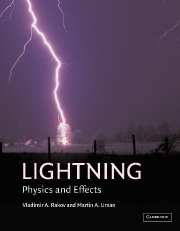Book contents
- Frontmatter
- Contents
- Preface
- 1 Introduction
- 2 Incidence of lightning
- 3 Electrical structure of lightning-producing clouds
- 4 Downward negative lightning discharges to ground
- 5 Positive and bipolar lightning discharges to ground
- 6 Upward lightning initiated by ground-based objects
- 7 Artificial initiation (triggering) of lightning by ground-based activity
- 8 Winter lightning in Japan
- 9 Cloud discharges
- 10 Lightning and airborne vehicles
- 11 Thunder
- 12 Modeling of lightning processes
- 13 The distant lightning electromagnetic environment: atmospherics, Schumann resonances, and whistlers
- 14 Lightning effects in the middle and upper atmosphere
- 15 Lightning effects on the chemistry of the atmosphere
- 16 Extraterrestrial lightning
- 17 Lightning locating systems
- 18 Deleterious effects of lightning and protective techniques
- 19 Lightning hazards to humans and animals
- 20 Ball lightning, bead lightning, and other unusual discharges
- Appendix: Books on lightning and related subjects
- Index
4 - Downward negative lightning discharges to ground
Published online by Cambridge University Press: 05 June 2013
- Frontmatter
- Contents
- Preface
- 1 Introduction
- 2 Incidence of lightning
- 3 Electrical structure of lightning-producing clouds
- 4 Downward negative lightning discharges to ground
- 5 Positive and bipolar lightning discharges to ground
- 6 Upward lightning initiated by ground-based objects
- 7 Artificial initiation (triggering) of lightning by ground-based activity
- 8 Winter lightning in Japan
- 9 Cloud discharges
- 10 Lightning and airborne vehicles
- 11 Thunder
- 12 Modeling of lightning processes
- 13 The distant lightning electromagnetic environment: atmospherics, Schumann resonances, and whistlers
- 14 Lightning effects in the middle and upper atmosphere
- 15 Lightning effects on the chemistry of the atmosphere
- 16 Extraterrestrial lightning
- 17 Lightning locating systems
- 18 Deleterious effects of lightning and protective techniques
- 19 Lightning hazards to humans and animals
- 20 Ball lightning, bead lightning, and other unusual discharges
- Appendix: Books on lightning and related subjects
- Index
Summary
The frequency distribution of lightning current amplitudes in earth flashes is reasonably well established. Over most of its range it can be said to follow a log-normal distribution but the frequency of occurrence of exceptionally high and low crest values remains to be established by greatly increased numbers of observation. Further study is also required of current amplitudes in tropical storms and in flashes to very tall structures. The most vital gap in present knowledge concerns the spatial and temporal variations of the current along the entire length of the discharge channel from ground to cloud.
R. H. Golde (1977)Introduction
Downward negative lightning discharges, that is, discharges that are initiated in the cloud, initially develop in an overall downward direction, and transport negative charge to ground, probably account for about 90 percent of all cloud-to-ground discharges (Section 1.2). The overall cloud-to-ground lightning discharge, termed a flash, is composed of a number of processes, some of which involve channels that emerge from the cloud while others involve channels that are confined to the cloud volume. Only processes occurring in channels outside the cloud render themselves to optical observations that can be used to determine channel geometry, extension speed and other pertinent features of those channels. All lightning processes are associated with the motion of charge and, therefore, can be studied via measurement of the electric and magnetic fields associated with that charge motion. VHF–UHF radiation associated with breakdown processes, particularly those involved in the formation of negatively charged leader channels, can be used to track channel extension, as discussed in subsections 17.4.2 and 17.6. Major insights into downward negative lightning processes that have been gained from triggered lightning experiments are included in this chapter; a detailed discussion of triggered lightning will be found in Chapter 7.
- Type
- Chapter
- Information
- LightningPhysics and Effects, pp. 108 - 213Publisher: Cambridge University PressPrint publication year: 2003
- 10
- Cited by



